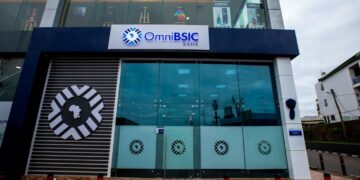Incessant policy rate hikes necessary for macroeconomic stability, growth – Governor Addison
Governor of the Bank of Ghana (BoG), Dr Ernest Addison, has remarked that the continuous increments in the apex bank’s benchmark interest rate is necessary to return Ghana’s economy to a disinflation path.
According to the Governor, the return to a disinflation path is a condition necessary for macroeconomic stability and growth.
Delivering the keynote address at the Chartered Institute of Bankers Ghana 2022 Annual Dinner, the Governor remarked that the aggressive policy tightening pursued by the Bank was underscored by the need to rein in inflationary pressures and re-anchor inflation expectations.
The Central Bank, since November 2021, has raised the policy rate from 14.5% to 27% as at end-November 2022, an increase of 12.5% in the Bank’s benchmark interest rate.
In response to the upward adjustments in the policy rate, the Governor noted that, interest rates broadly
trended upward across the spectrum of the yield curve.
The interbank weighted average rate increased to 23.98 percent in October 2022 from 12.66 percent in October 2021, consistent with the increases in the policy rate and the incremental hikes in the Cash Reserve Ratio from 12 percent in August 2022 to 14 percent in October.
In tandem, the average lending rates of banks rose to 31.40 percent in October 2022 from 20.34 percent in the same period of 2021.
Inflation rise to 40%
Inflation rate increased by 320 basis points (bps) from 37.2% in September to reach an all-year high of 40.4% in October.
The drivers of inflation appeared unchanged from the previous month as Housing, Water, Electricity, Gas, and other fuels rose to 69.6% rise in inflation compared to the 68.8% recorded in September, followed by Furnishings, Household Equipment, and Maintenance (55.7%); Transport (46.3%); Personal Care, Social Protection and Miscellaneous Goods and Services (45.5%) and Food and Non-Alcoholic Beverages (43.7%) which all recorded increases year-on year.
The month-on-month inflation between September 2022 and October 2022 rose by 70bps to reach 2.7%. The inflation rate remains well above the central bank’s inflation target band of 8+/-2%.
Food inflation increased to 43.7% which is up from September’s food inflation of 37.8%. Non-food inflation stood at 37.8%, compared to 36.8% recorded the previous month.
Overall month-on-month food inflation was 3.2% while non-food inflation stood at 2.3%. Inflation for imported goods was 43.7% while inflation for local goods was 39.1%. For the seventh consecutive month running, inflation for imported items exceeded domestic inflation.
At the regional level, the Eastern Region once again recorded the highest inflation rate of 51.1% while the Volta Region recorded the lowest inflation rate of 25.8%.
| MONTH | CPI (2018=100) | CHANGE (INFLATION %) | |
| MONTHLY | YEARLY | ||
| OCT – 2021 | 133.3 | 0.6 | 11.0 |
| NOV | 135.2 | 1.4 | 12.2 |
| DEC | 136.9 | 0.4 | 12.6 |
| JAN – 2022 | 139.7 | 2.1 | 13.9 |
| FEB | 143.0 | 2.4 | 15.7 |
| MAR | 148.8 | 4.0 | 19.4 |
| APR | 156.5 | 5.1 | 23.6 |
| MAY | 162.8 | 4.1 | 27.6 |
| JUN | 167.7 | 3.0 | 29.8 |
| JUL | 173.0 | 3.1 | 31.7 |
| AUG | 176.3 | 1.9 | 33.9 |
| SEP | 140.6 | 2.0 | 37.2 |
| OCT | 144.4 | 2.7 | 40.4 |
Gov’t targets 21.5% reduction in headline inflation
Meanwhile, Government, through the Central Bank and the use of its monetary tools, seeks to reduce the country’s record headline inflation of 40.4% to 18.9% at end-2023.
The reduction in headline inflation from 40.4% to 18.9% at end-2023 marks a 21.5% decrease on a year-on-year basis.
Making the 2023 budget statement presentation to Parliament on Thursday, November 24, Minister for Finance, Ken Ofori-Atta averred the Central Bank will continue to monitor inflation developments and respond appropriately to contain price pressures.
The end-2023 headline inflation rate target of 18.9%, the Finance Minister noted, is guided by government’s medium-term policy objectives following macroeconomic targets set for the medium-term (2023-2026) that include;
- Overall Real GDP to grow at an average rate of 4.3 percent;
- Non-Oil Real GDP to grow at an average rate of 4.0 percent;
- Inflation to be within the target band of 8±2 percent;
- Primary Balance on Commitment basis to average 0.8 % of GDP in the 2023-2026 period; and
- Gross International Reserves to cover at least 4 months of imports
For the 2023 fiscal year, macroeconomic targets set by government include;
- Overall Real GDP growth of 2.8 percent;
- Non-Oil Real GDP growth of 3.0 percent;
- End-December inflation rate of 18.9 percent
- Primary Balance on Commitment basis of 0.7% of GDP; and
- Gross International Reserves to cover not less than 3.3 months of imports.








